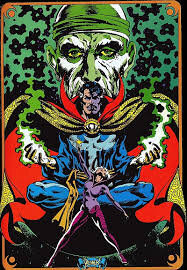
Marvel Comics in the 1970s
About This Project
This blog serializes the first draft of a book in progress, Marvel in the 1970s: The World Inside Your Head (under contract with Cornell University Press).
Marvel in the 1970s saw a transformation that initially looked seamless on the surface, but proved almost as dramatic as Bruce Banner turning into the Hulk. The new, younger writers who took over the titles shifted the emphasis and perspective from the “world outside your window” to the “world inside your head.” In a thoroughly visual medium and a decidedly action-oriented genre, these writers went beyond mere quirks of characterization and and angst-filled monologues to a quixotic attempt at interiority.
After a chapter about humanism in the era of Stan Lee, Jack Kirby, and Steve Ditko, this book/blog focuses on the work of five writers: Marv Wolfman (Tomb of Dracula), Doug Moench (Planet of the Apes, Werewolf by Night, Shang-Chi: Master of Kung Fu) , Steve Englehart (Avengers, Captain America, Captain Marvel, and Doctor Strange), Don McGregor (Black Panther and Killraven), and Steve Gerber (Howard the Duck, Man-Thing, Omega the Unknown, The Defenders). The comics they produced at Marvel during the 1970s were a crucial step forward in the evolution of the medium, but the peculiarities of the industry and market at the time have been an obstacle to a broader readership in the era of self-contained graphic novels.
Paper Movies
Gulacy's run on Master of Kung Fu is widely considered a high point, and for good reason
Games of Death and Deceit
All the conflicts are about maintaining Shang-Chi’s sense of self
Fighting and Talking
As readers, we are watching Shang-Chi, while Shang-Chi is watching himself
Orange Is the New Black Belt: The Problem of Shang-Chi, Master of Kung-Fu
Shang-Chi: Master of Kung Fu has a great deal working against it
Body and Soul
The villain must make the interior manifest, but in the process, he must also corrupt it, moulding it into a newly monstrous exterior.
Man and Beast
Werewolf by Night turns the multiple personality problem into a single personality problem
The Soul of an Old Machine
Deathok, rather than being an empty husk, has a surplus of selfhood
Weird Worlds
Doug Moench took on the sort of assignments that his colleagues were unlikely to covet
The Afterlife of Tomb of Dracula
Since the 1970s, Dracula has had no need of an inner life.
Vampire’s Progress
Does Dracula truly want absolute domination? And if he gets it, will he be satisfied?
The Lifecycle of Vlad Dracula
Redemption is a limit case that must be approached, but never reached
The Tragedy of the Naive Vampire Fan
Angie is Wolfman’s model of the bad reader, not just of Dracula, but of Tomb of Dracula
Women Who Love Vampires Too Much
Domini belongs to two lords at once: her husband and God.
Serial Obituaries
We can grow jaded by the parade of future corpses whom Dracula encounters on a nightly basis.
The League of Inherited Trauma
Vampires do not show up in mirrors; they are incapable of seeing themselves as other see them. It is up to Quincy, Rachel, and Frank to mirror Dracula back to him.
Vampire Meets Wolfman
How can the writer humanize a monster without humanizing him too much?



















